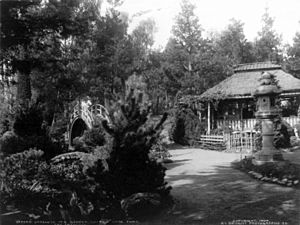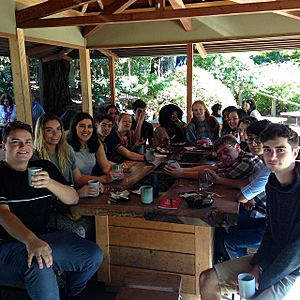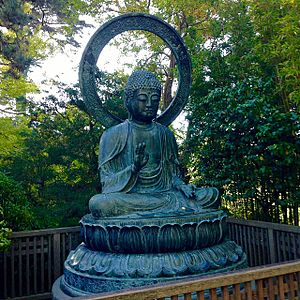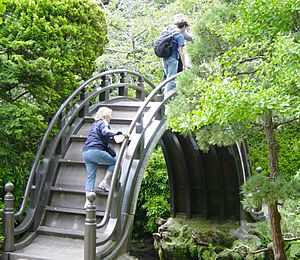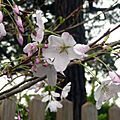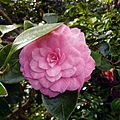Japanese Tea Garden (San Francisco) facts for kids
Quick facts for kids Japanese Tea Garden |
|
|---|---|
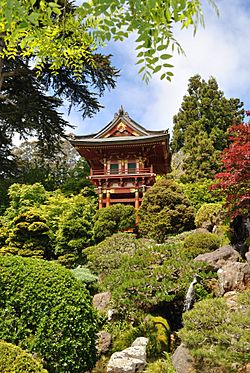
Japanese Tea Garden
|
|
| Lua error in Module:Location_map at line 420: attempt to index field 'wikibase' (a nil value). | |
| Type | Public |
| Location | San Francisco, California, United States |
| Nearest city | San Francisco |
| Area | 5 acres (2.0 ha) |
| Created | 1894 by George Turner Marsh [1] |
| Status | Open year round |
| Website | japaneseteagardensf.com |
The Japanese Tea Garden (Japanese: 日本茶園) in San Francisco, California, is a very popular spot in Golden Gate Park. It was first built for a big event called the California Midwinter International Exposition of 1894, which was like a World's Fair. Many parts of the garden today are from that original fair. Over the years, the garden has changed a lot to become the beautiful place it is now.
This garden is the oldest public Japanese garden in the United States. It has many paths, calm ponds, and a special teahouse. The plants and trees are carefully shaped in a Japanese style. The garden is about 5 acres big and has sculptures and buildings inspired by Buddhism and Shinto beliefs. It also uses lots of water and rocks to create a peaceful place that helps people relax.
Contents
History of the Garden
The Japanese Tea Garden started as the Japanese Village and Tea Garden at the 1894 World's Fair. An Australian man named George Turner Marsh built it. He hired skilled Japanese craftsmen to help create the site. After the fair ended, Marsh sold his part to the city of San Francisco.
Then, Makoto Hagiwara, a Japanese immigrant and gardener, was hired to manage the garden. He helped turn the temporary fair exhibit into the permanent Japanese Tea Garden. He was the garden's official caretaker for many years, from 1895 to 1925. He brought many plants, birds, and the famous koi fish from Japan. He also made the garden more than three times bigger!
After another big fair in San Francisco in 1915, called the Panama–Pacific International Exposition, some parts from its Japanese exhibits were moved to the Tea Garden. These included the South Gate, the Temple Gate, and the Pagoda.
Challenges and Changes
After Makoto Hagiwara passed away in 1925, his daughter, Takano Hagiwara, and her children took care of the garden. But during World War II, many Japanese Americans were sent to special camps. Takano Hagiwara and her family were forced to leave their home in the garden and go to one of these camps. About 120,000 Japanese and Japanese Americans were sent away during the war.
Even though the Hagiwara family had an agreement to stay for a century, they were not allowed to return to their home or get paid back after the war. While they were gone, the garden was even renamed "The Oriental Tea Garden." Some Japanese-style buildings, like the Hagiwara home and the original Shinto Shrine, were taken down.
Reconciliation and New Additions
In 1952, the garden's original name, "Japanese Tea Garden," was brought back. The Hagiwara family helped a little with making the garden beautiful again. The years after the war were about making things right.
In 1949, a large bronze Buddha statue was given to the garden. Because the Japanese Peace Treaty was signed in San Francisco in 1951, the Japanese Consul General, Yasasuke Katsuno, gave a huge 9,000-pound Lantern of Peace in 1953. Children in Japan collected small donations to pay for this lantern. It was a symbol of friendship for future generations in the United States.
Around this time, a designer named Nagao Sakurai created a "Peace Garden" and a dry landscape garden, also known as a karesansui. These are often called Zen Gardens outside of Japan. In 1974, a special plaque was added to honor Makoto Hagiwara and his family for all their hard work. In 1986, the road next to the garden was named Hagiwara Tea Garden Drive to remember them even more.
Special Features of the Garden
The Tea House
The Tea House has been a part of the Japanese Tea Garden since it first opened in 1894. It has been rebuilt a few times. In the past, women from the Hagiwara family served tea and rice cakes there.
The idea of drinking tea in a calm, natural setting comes from the sacred Japanese tea ceremony. This ceremony started a long time ago, around 1203 AD. Buddhist priests used tea to stay awake during their prayers. Over time, the ceremony became known as Chanoyu, which means "hot water for tea." Today, it's about carefully making and serving whipped green tea, called Matcha. When done well, it creates a very peaceful feeling.
The Tea House is located by the water, offering beautiful views of the garden. Today, you can enjoy six different kinds of tea there, including Jasmine, Sencha, and Matcha. They also offer snacks like Edamame and Green Tea Cheesecake.
“Treasure Tower” Pagoda
The pagoda in the Japanese Tea Garden is a five-story building used as a Buddhist shrine. It was first built for a temporary display at the 1915 Panama–Pacific International Exposition. After that fair, the pagoda and the Temple Gate were moved to the Japanese Tea Garden.
A pagoda is a tall building with many roofs, first used in India and East Asia for Buddhist purposes. There are two types: tombs for important monks, and shrines for worship. The one in this garden is a shrine. It was moved to where the original Shinto shrine used to be. This happened during World War II when the Shinto shrine was taken down due to anti-Japanese feelings.
Drum Bridge (Moon Bridge)
A taiko bashi, or drum bridge, is a highly arched bridge for walking, found in Chinese and Japanese gardens. It's called a "drum bridge" because when its reflection hits the water, it forms a full circle, like a drum. It's also known as a Moon bridge.
This bridge has three main purposes: to make people slow down and enjoy the view, to let boats pass underneath, and to create that beautiful full-circle reflection on the water. A bronze plaque on the bridge honors Shinshichi Nakatani for his special work on it.
Karesansui - Dry Landscape Garden
This part of the garden was designed by Nagao Sakurai and opened in 1953. In this type of garden, large stones and gravel raked into wavy patterns represent waterfalls and bodies of water. Some islands are shaped like tortoises, which are symbols of long life and good luck.
A karesansui, or dry landscape garden, is a Japanese garden style where stones and gravel stand for natural features like waterfalls, oceans, and mountains. Plants are sometimes used, but not always. The careful arrangement of stones can show an entire landscape.
The name "Zen Garden" was made up by an American author in 1935. While many of these gardens are found at Zen Buddhist temples, karesansui gardens are not only linked to Zen.
How the Garden is Designed
Trees in the Garden
The trees in the Japanese Tea Garden have a history of over a hundred years. You can find many kinds of trees here, like cherry trees, azaleas, magnolias, and Japanese maples. The small, dwarf trees were planted by the Hagiwara family after the 1894 fair.
When Japanese Americans were sent to internment camps in 1942, the Hagiwara family took their dwarf trees with them. These trees were later sold to a couple, Dr. Hugh and Audrey Fraser. In her will, Audrey Fraser made sure the trees were returned to the Japanese Tea Garden.
An expert named Samuel Newsom redesigned the dwarf trees in 1965. He placed them on the hillside near the waterfall. Most of these dwarf trees came from Japan, brought by the Hagiwara family. The oldest tree is a Japanese black pine, which is now supported by a bamboo frame near the Tea House.
Today, the Monterey pine trees need a lot of care. Every three years, their branches are carefully shaped into zig-zag patterns, which is a traditional Japanese style. These pines can be sixty feet tall, so city workers use ropes to climb and prune them.
Water Features
Water is very important in Japanese gardens. It represents purity and life. Ponds and waterfalls are often placed carefully to catch the sun's reflection. In the old Japanese religion, ponds were made for sacred reasons, as places for gods to visit. The sound of moving water in the Japanese Tea Garden makes it feel peaceful.
A Tsukubai is a stone water basin found in the garden. Guests used it to clean themselves before taking part in the tea ceremony. Even the dry garden shows the importance of water through its wave patterns made of gravel and artificial islands made of rocks. Water is a key part of Japanese Gardens and their connection to a special, timeless world.
Rocks in the Garden
Rocks are a very important part of traditional Japanese gardens. They are often seen as the main structure of the garden. They are also thought of as "homes for gods" and symbols of long life.
Rocks have three main uses in the garden. First, they can look like bigger natural things, like mountains or bodies of water. Second, they form rock groups. In Japanese Gardens, rocks are often placed together with one large rock as the main one. Other rocks are arranged around it to match its feeling. These groups of rocks look organized but are not perfectly even.
Third, rocks can guide your eyes to other parts of the garden. They point visitors towards the main design of the garden. Paths and stepping-stones are laid out in uneven ways so people slow down and notice the beauty around them. Also, in the Shinto religion, rocks have a special decorative role based on where they are placed. For example, a tall, upright stone might represent masculinity, while a low, flat stone represents femininity. This shows the Shinto belief that everything in nature has a balance of male and female energy. The Japanese Tea Garden combines ideas from both Shinto and Buddhist beliefs.
Cultural and Religious Design
The special design of a Japanese tea garden shows a lot about Japanese culture and religious ideas. This is seen through the respected art of landscaping and architecture. Japanese beauty has been shaped by Japan's island location, focusing on being separate and the importance of water. Both Buddhism and Shinto religions can be seen in the design of the Japanese Tea Garden.
Japanese Cultural Aesthetics
The design of a Japanese tea garden is greatly influenced by four main ideas of beauty in Japanese culture: miniaturization, concealment, extended scenery, and asymmetry.
Miniaturization
Miniaturization means showing the whole spirit of nature in a small space. The Japanese Tea Garden in San Francisco is only 5 acres, but it feels like a whole world. This idea also includes using small stones and other tiny things to represent the yin-yang. The Buddhist idea of yin-yang shows that everything around us is always changing and not complete on its own. It means different parts come together to make a bigger whole. In the San Francisco Japanese Tea Garden, water and stone coming together in waterfalls, stone water basins, and flat stones across ponds show the yin-yang.
Concealment
The garden's beauty is also shaped by the idea of concealment. This means messages are revealed bit by bit to show a bigger picture. For example, the dragon hedge in the Japanese Tea Garden only looks like a dragon when you follow it from its tail to its head.
Extended Scenery
Extended scenery makes the garden's small space seem larger. It uses natural elements from outside the garden. Even though the Japanese Tea Garden is in San Francisco, you can't tell it's surrounded by a city when you're inside. Tall green plants around it make the garden look bigger than it is.
Asymmetry
The fourth idea, asymmetry, is like a part of yin-yang. Asymmetry highlights that everything around us is abstract and always changing. This idea of beauty shows the Buddhist principle of Wabi-sabi, which says that all things are not perfect, are uneven, and don't last forever. You can see this in the garden's winding paths, stones of many different sizes, and objects placed in unusual ways. Also, changing the wave patterns in the dry Zen Garden is a tradition that honors wabi-sabi.
Religious Design Elements
The special design of the Japanese Tea Garden is influenced by different parts of Japanese culture and, more specifically, Japanese religion. The most important of these is the ancient Japanese religion of Shinto. The meaning of many things in the garden comes from the main ideas of Shinto, Buddhism, and even Taoism. All these religions strongly believe in the importance of nature and being connected to it. The way rocks are placed, how water flows, the paths, and the trees are all done to create a natural flow, as taught in Taoism.
In Shinto, people believe that the spirits of ancestors and gods, called Kami, live in nature. These Kami decide what happens to people on Earth. The garden is designed to make these spirits happy and to live well with them. Cleanliness is also very important in Shinto, and you can see this in how the park is structured; it's not meant to look crowded or hard to move around in. Also, the waterfall in the garden is a symbol of cleansing bad spirits, which is considered the purest way to clean oneself in Shinto. Even though the design shows many different parts of nature, flow, and Zen (which are basic ideas in Buddhism), it is done simply.
Steep Stairs
Many parts of the garden that visitors notice come from Buddhist ideas. The steep stairs in the garden are found in almost every place dedicated to Buddhism. In Buddhism, it's believed that you can reach Zen by climbing stairs, because movement is often part of meditation. This means exercise can help connect your mind, body, and spirit. Many monks and nuns exercise every day. It's also believed that Buddha himself said, "Good health is the highest gain." The steep stairs also remind people of the climb Buddha made to the top of Vulture Peak, his favorite place to meditate. That climb now has 1500 steps up a steep hill.
Stone Lanterns
The stone lanterns (tōrō) you see around the garden, like the Lantern of Peace given after World War II, represent the five elements of Buddhism. The bottom of the lanterns stands for earth, the next part is water, the light is fire, and the top two parts represent air and spirit. The lanterns as a whole show how all five elements come together in the harmony of nature. This is another example of wabi-sabi.
Gallery
See also
 In Spanish: Jardín japonés Hagiwara de San Francisco para niños
In Spanish: Jardín japonés Hagiwara de San Francisco para niños


